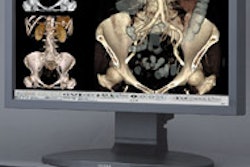DALLAS - PACS is widely accepted by referring physicians and produces measurable success, both in cost savings and improved patient care, according to a presentation Monday at the Healthcare Information and Management Systems Society (HIMSS) meeting.
Projected growth in imaging procedures requires effective management of clinical data, said Mark Domalewski, director of imaging services at Fairview Health Services, a large integrated delivery network (IDN) in Minnesota. And PACS is a key tool in meeting that challenge.
"PACS has become the cornerstone of our improvement efforts in imaging," Domalewski said.
Fairview consists of seven hospitals, 41 primary care clinics, 38 specialty clinics, and 21 senior care facilities. More than 6,000 physicians are affiliated with Fairview, and the network performed 542,000 imaging procedures in 2004.
PACS is at the forefront of Fairview's imaging initiatives, which include recruiting and retaining staff and handling the explosion in imaging procedure volume, Domalewski said.
The clinical benefits of PACS were a key driver for implementing the technology, said Pat Berger, Fairview's corporate director of information management services. Images are made available over Fairview's intranet or portal before the radiologist has interpreted the study, and multiple providers can view data virtually immediately after the exam is performed. And images can't be lost, taken, or be unavailable.
"Industry data suggests that as much as 25% of film-based radiology studies are not available at the time of care," she said. "And especially at our university site, we really found that to be the case, where we had so many times where the film was not available when it was needed."
Fairview also implemented a system with full RIS/PACS disaster recovery capability, including a business-continuation strategy, Berger said. In other PACS clinical benefits, the technology has led to a cut in interpretation times from days and weeks to minutes.
PACS also offers financial benefits. Fairview spent $1.5 million on film purchases a year, and required more than 100,000 square feet to store radiology film, Berger said. In addition, the facility's imaging operations had over 40 FTEs whose sole function was to handle radiology film, and Fairview's university hospital distributed over 500 radiology film jackets per day.
Implementation process
Fairview's RIS has been in place for seven years, while the IDN signed a PACS contract in April 2003 with IDX Systems of Burlington, VT. Fairview purchased and installed hardware and software at five metro hospitals, and is in the process of implementing PACS at the two remaining rural hospitals. That project is expected to be completed by June 1, Berger said.
Fairview has integrated over 200 imaging modalities with PACS, and converted three million patient records and over two million radiology reports from the previous hospital information system, she said.
"Our biggest accomplishment at Fairview is that all of our sites were virtually filmless and paperless the day we went live," she said. "This required a huge commitment from our administrators at our hospitals and our imaging directors. We decided from day one, that even though (the initial plan) had us ramping up to approximately 85% filmless over 18 months, we made a commitment with our first hospitals that went live to stand firm on being filmless, and were able to accomplish 90% filmless and paperless the day we went live with our PACS system."
The remaining 10% of film is largely produced by mammography exams. Fairview has not implemented digital mammography at all of its sites yet, but is planning to convert to FFDM, Berger said.
"We're hopeful that we'll actually be able to achieve close to 100% filmless at all of our sites," she said.
Fairview has also installed speech recognition at its university hospital, where radiologists perform their own editing, Berger said. As a result, there's no longer any need for transcriptionists for radiology at the university hospital, she said. Speech recognition will be rolled out to the remainder of Fairview's hospitals in 2005.
Fairview also committed to making operating rooms filmless when the PACS went live, she said. This involved steps such as installing 40-inch flat-panel LCDs outside the sterile area in the OR, and also employing operating room carts with displays for less-busy ORs.
Fairview also elected to make images available to clinicians immediately, prior to being read by radiologists.
"This has turned out to be extremely successful," she said. "We've actually had very good agreement from our radiologists, and they're used more on a consultative basis if they're not actually able to read the exams before the clinician needs to look at it in the ER, or the ICU, or surgery."
Fairview also chose to hire a full-time physician liaison for customer service, training clinicians in the use of PACS and accessing images online.
Easy access
Since implementing PACS, Fairview has realized vastly improved access to information for all of its customers, as well as integration with its electronic medical record and portal strategies, Berger said. In addition, clinicians have reported on its ease of use, and radiology report availability times have been reduced from days or hours to minutes, she said. Fairview has also accrued data integrity and security benefits.
As part of the system, Fairview has implemented an Imaging Manager Desktop application, or dashboard system. Available to all Fairview employees, the dashboard application offers access to statistics such as monthly report turnaround, monthly film cost per exam (by facility and by modality), monthly operating margin (by facility and by modality), and monthly tech productivity (exam/FTE) by facility and by modality.
"The dashboard allows for near-real-time assessment of imaging enterprise performance and success of our PACS," Domalewski said.
Overall, PACS has clearly increased referring physician satisfaction and reduced film costs by over $1 million a year, Domalewski said. Film file personnel costs have been cut by over $400,000 a year, and images are now available everywhere immediately, he said. And reports are available faster.
"PACS is a key enabler for electronic medical record deployment," he said.
By Erik L. RidleyAuntMinnie.com staff writer
February 15, 2005
Related Reading
3D JPEG 2000 compression shines in multislice CT data, February 9, 2005
Web-based application nets teleradiology benefits, January 31, 2005
In-depth approach needed for PACS security, January 20, 2005
PACS protects during SARS outbreak, January 7, 2005
ASP-powered PACS can slash costs, December 17, 2004
Copyright © 2005 AuntMinnie.com



















